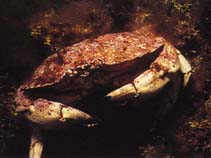Cancer borealis Stimpson, 1859
Jonah crab| Native range | All suitable habitat | Point map | Year 2050 |

|
| This map was computer-generated and has not yet been reviewed. |
| Cancer borealis AquaMaps Data sources: GBIF OBIS |
Классификация / Names народные названия | синонимы | CoL | ITIS | WoRMS
Malacostraca | Decapoda | Cancridae
Environment: milieu / climate zone / пределы глубины / distribution range экология
; пределы глубины 0 - 800 m (ссылка 367). Subtropical, preferred 11°C (ссылка 107945); 59°N - 20°N, 85°W - 52°W
Distribution страны | регионы FAO | Ecosystems | места находок | интродукции
Western Atlantic: from Newfoundland and Labrador, Canada to Dry Tortugas, Florida and Cuba.
Length at first maturity / Size / Weight / Возраст
половая зрелость: Lm 8.8 range ? - ? cm Max length : 16.0 cm CW самец/пол неопределен; (ссылка 101412); наибольший вес (опубликованные данные): 0.00 g
Краткое описание морфология
Carapace approximately 2/3 as long as wide, surface coarsely granulate; front (excluding inner orbital angles) with 3 teeth, middle one exceeding others and depressed (flattened dorsoventrally); anterolateral margins divided into 9 quadrangular lobes or teeth with margins minutely denticulate; notches between teeth continued on carapace as short, closed fissures. Pincers stout, nearly as long as second legs, carpus and hand with strong granulose rugae, upper margin of pincers denticulate, carpus with sharp inner dorsal spine. Color: red dorsally, yellow ventrally; back with 2 curved lines of yellowish spots and behind middle, a figure somewhat resembling letter H; legs mottled and reticulated with yellow and red, more or less purplish.
Minimum depth from Ref. 97531. Lives in deep water (Ref. 106868). Occurs from the intertidal zone among rocks to 800 m (Ref. 367). Common in shallow subtidal zone during summer (Ref. 106868). Small to medium-sized individuals are found near shore seasonally (especially in the south), while larger ones only occur in deeper water (Ref. 367). Moves from subtidal into low intertidal with the tide (Ref. 106868). Found in rocky bottom in association with Homarus americanus. Also on rubble and soft substrate (Ref. 97531). Feeds mainly on mollusks, echinoderms, and other invertebrates (Ref. 367). Preyed upon by gulls (Ref. 106868).
Life cycle and mating behavior половая зрелость | размножение | нерест | Eggs | Fecundity | Larvae
Members of the order Decapoda are mostly gonochoric. Mating behavior: Precopulatory courtship ritual is common (through olfactory and tactile cues); usually indirect sperm transfer.
Основная ссылка
ссылки | координатор | соавторы
Tavares, M. 2003. (ссылка 367)
Статус Красного Списка МСОП
(ссылка 130435: Version 2024-2)
Статус СИТЕС (ссылка 108899)
Not Evaluated
CMS (ссылка 116361)
Not Evaluated
Угроза для людей
Использование человеком
рыболовство: коммерческий
FAO - рыболовство: landings | FishSource | Sea Around Us
инструменты
дополнительная информация
Trophic Ecology
экология
Population dynamics
рост
Max. ages / sizes
Length-weight rel.
Length-length rel.
Размерный состав
Mass conversion
пополнение
численность
Max. ages / sizes
Length-weight rel.
Length-length rel.
Размерный состав
Mass conversion
пополнение
численность
Life cycle
Distribution
Human Related
Aquaculture profiles
Stamps, coins, misc.
Stamps, coins, misc.
Outreach
ссылки
ресурсы в Интернет
BHL | BOLD Systems | CISTI | DiscoverLife | FAO(рыболовство: ; publication : search) | Fishipedia | GenBank (Геном, Нуклеотид) | GloBI | Gomexsi | Google Books | Google Scholar | Google | PubMed | Tree of Life | Wikipedia (Вперёд, поиск) | Zoological Record
Estimates based on models
Preferred temperature
(Ref. 115969): 1.6 - 17.9, mean 6.4 (based on 149 cells).
Nutrients : Calcium = 109 [35, 184] mg/100g; Iron = 1.59 [1.21, 1.97] mg/100g; Protein = 20.2 [19.2, 21.3] %; Omega3 = 0.285 [0.185, 0.386] g/100g; Selenium = 48.3 [-31.7, 128.3] μg/100g; VitaminA = 0 μg/100g; Zinc = 1.79 [1.17, 2.40] mg/100g (wet weight); based on nutrient studies.



